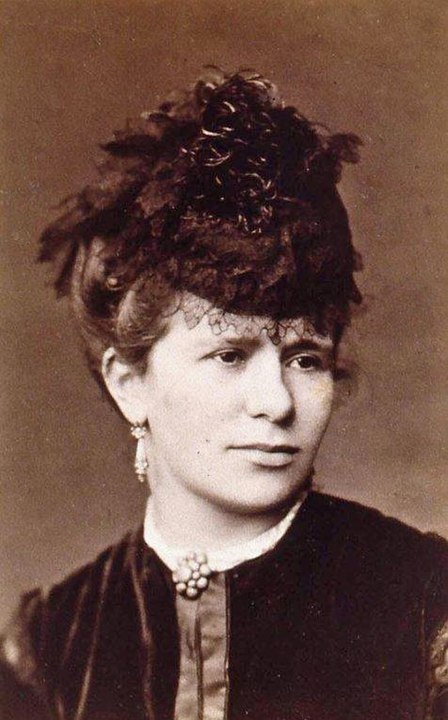Ressenya
Marie Jaëll was an excellent pianist from childhood. Although she composed for voice and instrumental ensemble, she is noted for her pedagogical work with the creation of the Jaëll Method for teaching music, which revolutionised piano technique at the time.
Justificacions
- Composer, pianist, pedagogue and music theorist.
- Innovator of piano pedagogy through physiology and neuroscience.
- She created the "Jaëll Method" as an innovative approach to musical practice.
Biografia
The Alsatian composer Marie Jaëll began studying the piano at the age of 6. She was a child prodigy who, at the age of 10, gave a series of recitals in Paris. In 1862, she won First Prize for Piano at the Paris Conservatoire. At the same time, she toured Europe giving concerts in Switzerland, Germany, England, Alsace and Paris. At the age of 20, in 1866, she married the pianist Alfred Jaëll, with whom she continued her brilliant virtuoso career.
A pupil of the leading European pianists of the time, she published her first works as a composer around 1871. She was one of the first women to be admitted to the Société des Compositeurs in Paris.
As a renowned pianist, she was the first performer of Beethoven's 32 Sonatas. At the age of 45, after suffering from tendinitis, she gave up the glory of public life to devote herself entirely to research into the "laws of art", focusing on research into piano performance, drawing on sciences such as anatomy, physiology, physics, chemistry, mathematics and psychology.
His fundamental work was his Method of Physiology (Méthode Jaëll), which revolutionised ideas about piano technique. His thinking can be summed up in the sentence "Body and spirit, movement and thought are one and the same force. The energy of movement is in contact with the intensity of the mental representation of the same movement". His work will consist of promoting musical practice with an internal mental intensity, which associates different states of movement and consciousness, up to a mental representation that links them together and which is the guarantee of the artist's inner unity.
Obres
Espanyol
Scores
- Impromptu, piano (1871)
- Deux méditations, piano (1871)
- Sis petits morceaux, piano (1871)
- Sonate pour piano (1871)
- Dix bagatelles, piano (1872)
- Valses pour piano à quatre mains, Op. 8 (1874)
- Quatuor à cordes (1875)
- Quatuor en sol mineur, piano, violon, alto et violoncelle (1875)
- Concert n.º 1 en re m para piano y orquesta (1877)
- Bärenlieder, La Légende des Ours, soprano y piano (1879)
- Am Grabe eines Kindes: obra para tres coros (1880)
- Runéa, ópera en 3 actos (1878)
- 5 Lieder, voz y piano (1879)
- Ossiane, poema sinfónico (1879)
- Sonate pour violon (1881)
- Concerto pour violoncelle (1882)
- Concerto n.º 2 en do m para piano y orquesta (1884)
- Sphinx, piano (1885)
- Voix du printemps: Sur la grand route, orquesta (1885)
- Voix du printemps, piano a 4 manos (1885)
- Voix du printemps, para orquesta (1885)
- Adagio, alto y piano (1886)
- Ballade (1886)
- Valses mélancoliques, piano (1888)
- Valses mignonnes, piano (1888)
- Promenade matinale: esquisses pour piano, Op. 58 (1889)
- Les Orientales, voz (1893)
- Trois Pièces pour piano (1894)
- Sept pièces faciles pour piano (1899)
- Psaume LXV, coro en cuatro partes, inédito (1917)
- Recueil de chansons, canto y piano (1917)
- Harmonies d’Alsace, orquesta (1917)
Pedagogic Works
- Jaëll, Marie (1894). Le Toucher, nouveaux principes élémentaires pour l’enseignement du piano. París: Heugel & Cie, 2 vols.
- Jaëll, Marie (1896). La musique et la psychophysiologie. París: Baillière.
- Jaëll, Marie (1897). Le mécanisme du toucher: l’étude du piano par l’analyse expérimentale de la sensibilité tactile. París: Colin.
- Jaëll, Marie (1899). Le Toucher, Enseignement du piano basé sur la physiologie. Leipzig, París: Breitkopf, Härtel, Costallat, 3 vols.
- Jaëll, Marie (1904). L’intelligence et le rythme dans les mouvements artistiques. París: Alcan.
- Jaëll, Marie (1909). Les rythmes du regard et la dissociation des doigts. París: Fischbacher.
- Jaëll, Marie (1910). Un nouvel état de conscience: la coloration des sensations tactiles. París: Alcan.
- Jaëll, Marie (1912). La résonance du toucher et la topographie des pulpes. París: Alcan.
- Jaëll, Marie (1922). Nouvel enseignement musical et manuel basé sur la découverte des boussoles tonales. París: les Presses Universitaires de France.
- Jaëll, Marie (1927). La main et la pensée musicale. París: P.U.F.
- Jaëll, Marie (1927). Le toucher musical par l’éducation de la main: un nouvel enseignement artistique. París: P.U.F.
Bibliografia
Briscoe, J. R. (1987). Historical Anthology of Music by Women. Bloomington and Indianapolis: Indiana University press.
Chantavoine, J. (1952). “Lettres inédites de Liszt à Alfred et Marie Jaëll”, en Revue Internationale de Musique, vol. 12, pp. 31-47.
Cooper, G.W. & Meyer, L.B. (1971). The Rhythmic Structure of Music. Chicago: The University of Chicago Press.
Hurpeau, L. (2004). Marie Jaëll: un cerveau de philosophe et des doigts d’artiste. Lyon: éditions Symétrie.
Kiener, H. et Siegfried, A. (1989). Marie Jaëll 1846-1925: problèmes d’esthétique et de pédagogie musicales. Nantes: Editions de l’Arche.
Pendle, K. (1991). Women and Music. Bloomington: Indiana University Press.
Wright, G. (1987). France in Modern Times. New York: Norton, Fourth Edition.
Enfocament Didàctic
In Music of Secondary Education, in Foreign Language and in active listening activities.
In Professional and Higher Music Education, in the subjects of Piano, Instrumental Ensemble and Singing.
At University, in Teacher Training, in subjects with competences in Music.
Documents
